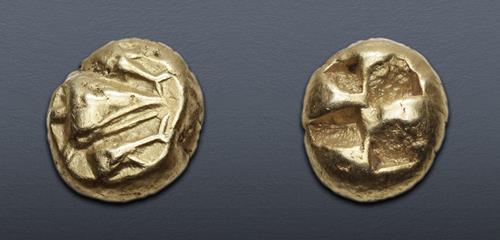
|
MYSIA, Kyzikos. Circa 600-550 BC. EL Hekte – Sixth Stater (9mm, 2.68 g).
Triton XXV
Lot: 213. Estimated: $ 1 000
Greek, Coin-in-Hand Video, Electrum
Sold For $ 1 300. This amount does not include the buyer’s fee.
Go to Live
|
|
MYSIA, Kyzikos. Circa 600-550 BC. EL Hekte – Sixth Stater (9mm, 2.68 g). Head of tunny right; above and below, small headless tunny left / Quadripartite incuse square. Cf. Hurter & Liewald III 14.1 (hemihekte); Von Fritze I –; Boston MFA –; SNG BN –; cf. SNG von Aulock 7263 (hemihekte); CNG 115, lot 176; CNG E-400, lot 121; Triton XIII, lot 1266. Minor flan flaw on obverse. VF. Very rare.
The celebrated electrum coinage of Kyzikos began in the first half of the sixth century, and from the beginning the coinage was notable for the variety and inventiveness of its designs. These staters and fractions were regarded as gold coins and circulated throughout a large area along with the gold darics of the Persian Empire. On all of the coins of Kyzikos, large or small, was engraved the tunny-fish (θυννος), which constituted an important product in the Kyzikene economy. The long awaited corpus initiated by the late Friedrich Bodenstedt is now being continued by Maria Kaiser-Raiss. In the meantime, we must rely on the synthesis of material put together by Hans von Fritze in 1914, augmented (and corrected) by the articles by Sylvia Hurter and Hans-Joachim Liewald. Hurter studied the electrum coinage of Kyzikos for some time before her untimely death in 2008. It was her conviction that the arrangement of the coins by Agnes Baldwin Brett in the catalog of the Boston Museum of Fine Arts was the most accurate to date (reflected in the “Editor’s note” at the beginning of the article on the Kyzikene coins in Moscow and St. Petersburg in SNR 2007). Thus, the coinage of Kyzikos below is arranged accordingly.
More controversially, Yuri Pokras ("A New Iconography for the Electrum Coins of Kyzikos," The Celator November 2000, pp.18-26) has tried to argue that Athens invested Kyzikos with the status of subsidiary mint, and that the presence of specific types parallels each city-state’s inclusion into an alliance with Athens.
The orator Aristotelis, in the second century BC, stated the following in his speech regarding the people of Kyzikos: “It is enough for one just to glance at the location and the nature of this city to immediately understand that the name ‘blissful’ given to it by God was factual, so convenient is its land and its sea. As it is built in front of Asia Minor and since its dominion extends from the Black Sea to the Hellespont, Kyzikos joins the two seas together or rather all the seas that man navigates. Thus, ships continuously pass by or arrive at the harbor or depart from the harbor. Justly it should be called ‘blissful’ just as is Corinth because, as it is built in the mid part of the seas, it joins, as if it was the center of the world, all men who sail the Mediterranean from Gibraltar to Kolchis at the far side of the Black Sea.”
The final winners of all Triton XXV lots will be determined at the live public sale that will be held on 11-12 January 2022. Triton XXV – Session One – Greek Coinage (Part 1) will be held Tuesday morning, 11 January 2022 beginning at 9:00 AM ET.
Winning bids are subject to a 20% buyer's fee for bids placed on this website and 22.50% for all others.
We recognize that our users may have various Internet Browsers and Operating Systems. We like our visitors to have the best possible experience when using our bidding platform. However, we do recognize that it is impossible to develop applications that work identically, efficiently and effectively on all web browsers. The CNG bidding platform supports the latest stable major version and the stable previous version of Mozilla Firefox and Chrome.
|
